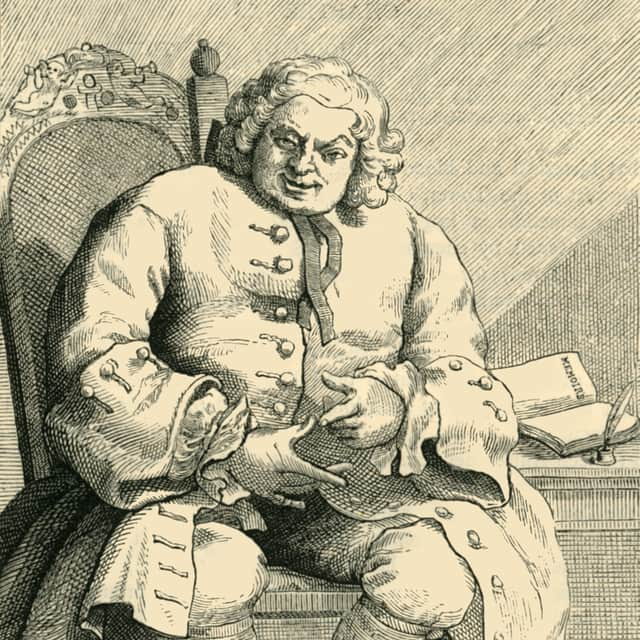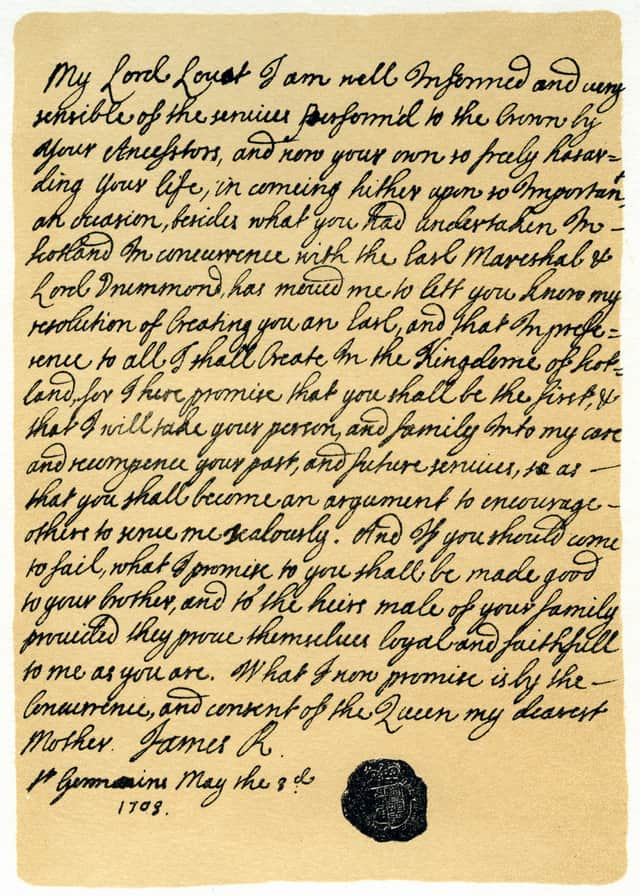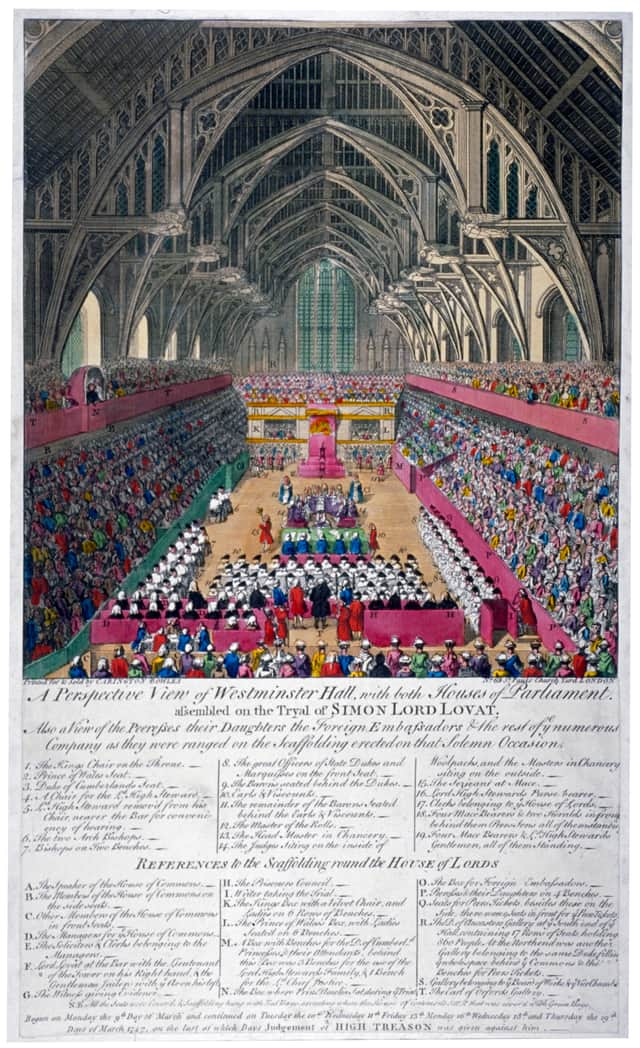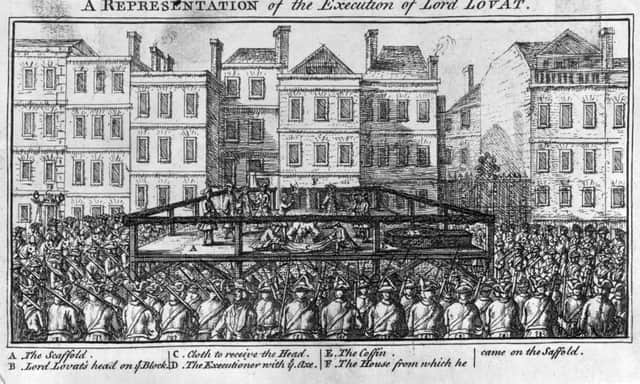Simon Fraser: Grandfather of Outlander's Jamie Fraser, and real life Jacobite and Lord - the last man to be beheaded in England
This article contains affiliate links. We may earn a small commission on items purchased through this article, but that does not affect our editorial judgement.
Outlander fans may recognise Simon Fraser as the grandfather of Jamie Fraser, but the 11th Lord Lovat is best known as the last man to have been executed by beheading in Britain.
Fraser was said to have lived a colourful life and was eventually condemned for his part in the 1746 Jacobite uprisings.
Advertisement
Hide AdAdvertisement
Hide AdHe was known as a wily character - the Old Fox, he was called - and though he was sentenced to be hung, drawn and quartered, Simon Fraser was instead the last man to die by beheading in England.
Simon Fraser was an ambitious man
Born in the Highlands of Scotland in 1667, Simon Fraser lived a colourful life.
Not much is known about his earliest years, however he is said to have been educated at King’s College in Aberdeen around the year 1691, following the death of his elder brother, Alexander. Alexander fought for the Jacobites and lead the Frasers in the Battle of Killiecrankie, where he was wounded in battle and killed. This led to Simon Fraser being named his father’s heir.


He was a successful student who went on to gain a Master of Arts from Aberdeen University. He initially planned on continuing his education, though his priorities shifted and he instead grew concerned with succeeding Hugh Fraser as Lord Lovat, Clan chief of the Fraser’s.
Simon wasn’t pleased with the way Hugh - whom he described as a man of “contracted understanding” - was leading the clan, and felt they seemed weak against the growing Mackenzie clan.
When Hugh Fraser passed away, Simon decided the best way to secure the Lordship would be to marry his heir; Hugh’s daughter Amelia. But Amelia’s uncle, Lord John Murray, had other plans and he married his niece off to Alexander Mackenzie, heir to Lord Saltoun. In response, Simon Fraser forced her mother - whose name was also Amelia - into marriage, and consummated the ceremony by raping her.
This incited a feud with her family, the Murrays of Atholl, and following a series of legal battles - including a trial for the “rapt” of the dowager Lady Lovat - he was outlawed, with a price on his head.
Fraser’s history of betrayal
Simon fled to France, where he travelled in Jacobite circles making contact with the court of exiled Stuarts. He was granted an audience with King Louis IX, where he declared his support for the Jacobite cause and restoring a Stuart King to the Scottish throne. In addition, it is said he helped form the basis of a plan for the Jacobite uprising.
However, his main goal was still to claim the Lordship.
Advertisement
Hide AdAdvertisement
Hide AdSimon returned to Britain on a Jacobite mission, but instead acted as a double agent. He informed James, 2nd Duke of Queensberry and the Queen’s Scottish representative, of the impending uprising.
The news of Simon being back in Britain began to spread - as did word of his treachery - and he escaped back to France, to wait and see if he would be pardoned for his crimes.
On his return to the country, the French court found out about his double-cross and Simon was sentenced to life in exile.


Restoration of titles
Back in Scotland very few of the Fraser Lairds had accepted Alexander Mackenzie as their chief, and several men were sent to France to retrieve Simon.
Unfortunately for him, Alexander was caught up on the losing side of the 1715 Jacobite uprisings, and condemned to prison.
Simon had spent ten years in captivity in France and finally returned to Scotland following his escape in 1715. For his service to the government, he was granted a full pardon and the title of Lord Lovat was restored to him alongside the “liferent” of the coveted estates.
His previous marriage was all but forgotten and Simon Fraser, Lord Lovat, married Margaret Grant. The couple shared five children, two of whom were boys, securing his family’s hold on the Lordship.
Simon spent much of his time after gaining the title and estate untangling legal and financial problems, only gaining complete possession of both in 1733.
A Jacobite until the end
Advertisement
Hide AdAdvertisement
Hide AdThroughout all this, and despite his betrayal, Simon always claimed Jacobite sympathies.
When the 1745 rising came around, Simon was unsure which side to join - even after his 19-year-old son gathered a group of clansmen to join Bonnie Prince Charlie. The government grew impatient with Simon’s lack of declaration for either side and demanded his presence in Inverness, where he was swiftly confined to his townhouse.
Escaping through a secret passage, Lord Lovat officially declared his support for the Jacobite cause and his clansmen went to fight in the battle. Fighting on the front line, the Fraser clan was slaughtered on Culloden Moor.


Lord Lovat escaped to the Highlands, just one day after the Bonnie Prince. His home, Castle Dounie, had been pillaged and burnt to the ground by the Redcoats.
Simon was eventually caught by the Redcoats on an island in Loch Morar while trying to arrange transportation back to France, and was brought to London for trial.
Suffering from gout and arthritis, at an advanced age, Simon stood trial for six days. His fate had already been decided and not even his own defence could have changed the guilty verdict which was delivered in a hall filled with many of his former friends.
The Lord Lovat was sentenced to be hung, drawn and quartered - the typical punishment for treason.
However, the King took mercy on the old man and in the end he was beheaded.
Simon Fraser was the last man beheaded in England
Advertisement
Hide AdAdvertisement
Hide AdBroadsheets from the time reported that Simon accepted his fate with a grim sense of humour and “gaiety”.
His death was a public spectacle.
On April 9, 1747, spectators arrived at Tower Hill in droves to watch his execution. So many, in fact, that a wooden stand holding spectators collapsed and killed nine people - much to the Lovat’s amusement.
He was said to keep his good sense of humour until the end.


Upon looking out at the crowd which had gathered to watch his death, he reportedly said: “God save us, why should there be such a bustle about taking off an old grey head that can't get up three steps without two men to support him?”
He felt the axe which was set to take his head before he was helped to kneel.
It is said that among his last words were a line of Horace: “Dulce et decorum est pro patria mori” or “It is sweet and seemly to die for one’s country”.
And when the blade fell, Simon Fraser, Lord Lovat became the last man in Britain to be executed from beheading.
The Old Fox’s final resting place
The final resting place of Lord Lovat continues to be a mystery. For more than 270 years it was believed that supporters smuggled his remains out of London and to the Highlands.
Advertisement
Hide AdAdvertisement
Hide AdHowever, in 2017 the coffin which was believed to be Lovat’s was exhumed from Wardlaw Mausoleum near Inverness by Dame Sue Black, a forensics expert at the University of Dundee.
The partial skeleton instead belonged to a young woman and the search for his remains returned to London where his supposed burial spot at the Tower of London is marked with a plaque.
Comments
Want to join the conversation? Please or to comment on this article.
